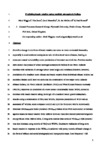Predicting beach rotation using multiple atmospheric indices
| dc.contributor.author | Wiggins, Mark | |
| dc.contributor.author | Scott, Tim | |
| dc.contributor.author | Masselink, Gerd | |
| dc.contributor.author | McCarroll, Jak | |
| dc.contributor.author | Russell, Paul | |
| dc.date.accessioned | 2020-05-21T14:07:36Z | |
| dc.date.available | 2020-05-21T14:07:36Z | |
| dc.date.issued | 2020-08 | |
| dc.identifier.issn | 0025-3227 | |
| dc.identifier.issn | 1872-6151 | |
| dc.identifier.other | 106207 | |
| dc.identifier.uri | http://hdl.handle.net/10026.1/15697 | |
| dc.description | 12 month embargo required. | |
| dc.description.abstract |
Shoreline change in the form of beach rotation can occur at event to decadal timescales, especially in semi-sheltered embayments with bi-directional wave climates, leading to enhanced coastal vulnerability under predictions of increased sea level rise. Previous studies have shown that phases of winter-averaged atmospheric indices in the North Atlantic correlate with variations in average winter wave height and dominant direction; however, predictions of a localised wave climate and beach rotation from individual climate indices has exhibited limited skill. Here we show that the combination of two major north Atlantic climate indices, the North Atlantic Oscillation (NAO) and West Europe Pressure Anomaly (WEPA), improves the prediction of a wave power directionality index (WDI), known to correlate with beach rotation along the length of a headland bound gravel embayment. Results using a combination of NAO and WEPA, improves predictions of WDI with an associated R2 of 0.66, when compared to 0.23 and 0.31 for NAO and WEPA individually. Hindcast (WDIWW3) and index predicted (WDIPred) values of the WDI were shown to validate against measured beach rotation from 2008 to 2018 and modelled inshore potential longshore energy fluxes from 1980 to 2018. A long-term historic time series of WDIPred (1906–present) was then hindcast using records of NAO and WEPA. Qualitative validation of long-term beach rotation in response to the WDIPred is achieved with proxy records of beach change in the form of oblique and aerial photography and topographic maps. Low frequency (~60 years) beach rotation is shown to follow phases of the detrended cumulative WDIPred values, over the period of 1906 to 2018, linked to the multi-decadal fluctuations in detrended cumulative values of NAO and WEPA. When examined in the context of millennial-scale proxy NAO records, it is clear the recent centurial-scale analysis does not capture past variability and duration. This work has shown that: (1) potential future season ahead forecasts of atmospheric indices may skilfully predict beach rotation in many regions with bi-directional wave climates; and (2) historical analysis highlights the potential past phases of extreme coastal realignment. These new insights will lead to proactive and informed management from local authorities and coastal engineers. | |
| dc.format.extent | 106207-106207 | |
| dc.language | en | |
| dc.language.iso | en | |
| dc.publisher | Elsevier BV | |
| dc.subject | Beach rotation | |
| dc.subject | NAO | |
| dc.subject | WEPA | |
| dc.subject | Climate indices | |
| dc.subject | Atmospheric variability | |
| dc.subject | N Atlantic | |
| dc.title | Predicting beach rotation using multiple atmospheric indices | |
| dc.type | journal-article | |
| dc.type | Journal Article | |
| plymouth.author-url | https://www.webofscience.com/api/gateway?GWVersion=2&SrcApp=PARTNER_APP&SrcAuth=LinksAMR&KeyUT=WOS:000540488000007&DestLinkType=FullRecord&DestApp=ALL_WOS&UsrCustomerID=11bb513d99f797142bcfeffcc58ea008 | |
| plymouth.volume | 426 | |
| plymouth.publication-status | Published | |
| plymouth.journal | Marine Geology | |
| dc.identifier.doi | 10.1016/j.margeo.2020.106207 | |
| plymouth.organisational-group | /Plymouth | |
| plymouth.organisational-group | /Plymouth/Admin Group - REF | |
| plymouth.organisational-group | /Plymouth/Admin Group - REF/REF Admin Group - FoSE | |
| plymouth.organisational-group | /Plymouth/Faculty of Science and Engineering | |
| plymouth.organisational-group | /Plymouth/Faculty of Science and Engineering/School of Biological and Marine Sciences | |
| plymouth.organisational-group | /Plymouth/REF 2021 Researchers by UoA | |
| plymouth.organisational-group | /Plymouth/REF 2021 Researchers by UoA/UoA07 Earth Systems and Environmental Sciences | |
| plymouth.organisational-group | /Plymouth/Research Groups | |
| plymouth.organisational-group | /Plymouth/Research Groups/Marine Institute | |
| plymouth.organisational-group | /Plymouth/Users by role | |
| plymouth.organisational-group | /Plymouth/Users by role/Academics | |
| plymouth.organisational-group | /Plymouth/Users by role/Researchers in ResearchFish submission | |
| dcterms.dateAccepted | 2020-04-12 | |
| dc.rights.embargodate | 2021-5-5 | |
| dc.identifier.eissn | 1872-6151 | |
| dc.rights.embargoperiod | Not known | |
| rioxxterms.versionofrecord | 10.1016/j.margeo.2020.106207 | |
| rioxxterms.licenseref.uri | http://www.rioxx.net/licenses/all-rights-reserved | |
| rioxxterms.licenseref.startdate | 2020-08 | |
| rioxxterms.type | Journal Article/Review | |
| plymouth.funder | Physical and biological dynamic coastal processes and their role in coastal recovery (BLUE-coast)::NERC | |
| plymouth.funder | Physical and biological dynamic coastal processes and their role in coastal recovery (BLUE-coast)::NERC |



